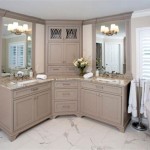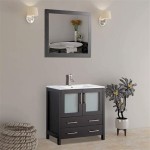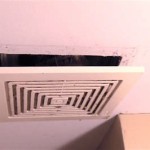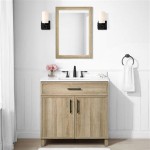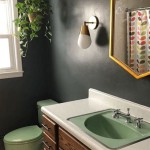How to Measure Bathroom Cabinet Hinges
Bathroom cabinet hinges are essential components that allow doors to open and close smoothly. Choosing the right hinges is crucial for both functionality and aesthetics. To ensure a perfect fit, accurate measurements are necessary. This article will guide you through the process of measuring bathroom cabinet hinges, covering various aspects to ensure success in your project.
1. Determine Hinge Type
The first step is to identify the type of hinge you need. Bathroom cabinets typically utilize two main hinge types: *
Overlay hinges
: These hinges are mounted on the cabinet door's exterior surface, allowing the door to overlay the cabinet face. *Inset hinges
: These hinges are installed inside the cabinet, allowing the door to sit flush with the cabinet face.Overlay hinges are more common in bathroom cabinets due to their ease of installation and versatility. Inset hinges offer a sleek, minimalist look. Once you have determined the hinge type, you can proceed with the measurement process.
2. Measure Cabinet Door Thickness
Accurate measurement of the cabinet door thickness is critical for choosing the appropriate hinge size. Using a tape measure, measure the thickness of the cabinet door at its thickest point, ensuring that you include any trim or molding. Record the measurement in millimeters or inches, depending on your preference and the unit of measurement used by the hinge manufacturer.
The hinge size should be compatible with the door thickness. Most hinges are available in standard sizes, such as 35mm, 32mm, and 26mm. If you are unsure, refer to the hinge manufacturer's specifications or consult a hardware professional.
3. Determine Hinge Placement
The placement of the hinges on the cabinet door is crucial for optimal functionality. Measure the height of the cabinet door and divide it by three. The top hinge should typically be positioned approximately one-third of the door's height from the top edge, while the bottom hinge should be placed one-third of the door's height from the bottom edge. For larger doors, consider adding a third hinge in the middle.
When determining the placement, ensure that the hinge positions are symmetrical and allow for sufficient door clearance when opened. The hinge placement should also take into account the desired hinge position on the cabinet frame, ensuring that the door aligns properly.
4. Measure Hinge Arm Length
The hinge arm length is essential for ensuring that the door opens and closes smoothly. This measurement is typically provided by the hinge manufacturer. However, if you need to measure it yourself, extend the hinge arm fully and measure the distance from the hinge base to the end of the arm.
For overlay hinges, the hinge arm length should be long enough to allow the door to open freely and close without hitting the cabinet frame. For inset hinges, the arm length should be sufficient to allow the door to sit flush with the cabinet face. If the arm is too short, the door will not open fully, and if it is too long, it can interfere with the door's closing mechanism.
5. Determine Hinge Cup Size
The hinge cup size refers to the diameter of the hinge cup, which is the part of the hinge embedded in the cabinet door or the cabinet frame. The cup size should match the cabinet material thickness. An oversized cup can weaken the door or frame, and an undersized cup may not provide adequate support. To measure the cup size, use a caliper or a tape measure to determine the inside diameter of the cup.
Refer to the hinge manufacturer's specifications for recommended cup sizes based on the cabinet material thickness. Many hinges are available in different cup sizes to accommodate various thicknesses. Ensure you choose a cup size that is compatible with your cabinet materials and the hinge type.
6. Consider Additional Measurements
Depending on the hinge type, you may need to consider additional measurements, such as the hinge offset, which refers to the distance between the hinge axis and the cabinet face. The offset measurement is crucial for ensuring that the door sits flush with the cabinet face. Additionally, for overlay hinges, you may need to measure the hinge gap, which is the distance between the door edge and the cabinet face when the door is closed. The gap should be consistent throughout the door to ensure a seamless look.
By carefully considering all the necessary measurements, you can effectively measure bathroom cabinet hinges and choose the appropriate size and type for your project. Remember to double-check your measurements and refer to the hinge manufacturer's specifications for guidance whenever possible.

3 Simple Ways To Measure Cabinet Hinges Wikihow

3 Simple Ways To Measure Cabinet Hinges Wikihow

3 Simple Ways To Measure Cabinet Hinges Wikihow

3 Simple Ways To Measure Cabinet Hinges Wikihow
Measuring Hinge Holes

Measuring Hinge Holes

3 Simple Ways To Measure Cabinet Hinges Wikihow

Measuring Hinge Holes

3 Simple Ways To Measure Cabinet Hinges Wikihow

2 Pieces 135 Degree Corner Cabinet Door Hinge Ubuy
